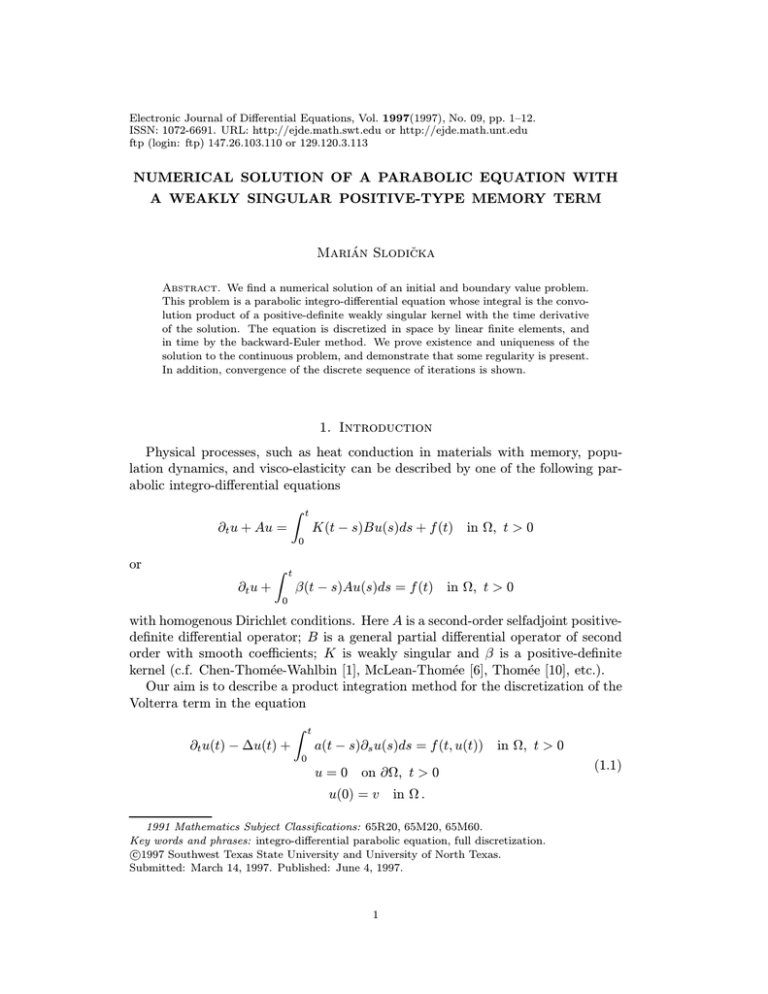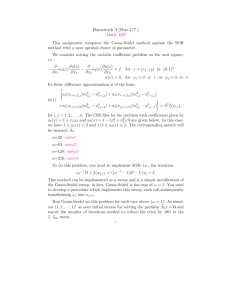Electronic Journal of Differential Equations, Vol. 1997(1997), No. 09, pp.... ISSN: 1072-6691. URL: or
advertisement

Electronic Journal of Differential Equations, Vol. 1997(1997), No. 09, pp. 1–12.
ISSN: 1072-6691. URL: http://ejde.math.swt.edu or http://ejde.math.unt.edu
ftp (login: ftp) 147.26.103.110 or 129.120.3.113
NUMERICAL SOLUTION OF A PARABOLIC EQUATION WITH
A WEAKLY SINGULAR POSITIVE-TYPE MEMORY TERM
Marián Slodička
Abstract. We find a numerical solution of an initial and boundary value problem.
This problem is a parabolic integro-differential equation whose integral is the convolution product of a positive-definite weakly singular kernel with the time derivative
of the solution. The equation is discretized in space by linear finite elements, and
in time by the backward-Euler method. We prove existence and uniqueness of the
solution to the continuous problem, and demonstrate that some regularity is present.
In addition, convergence of the discrete sequence of iterations is shown.
1. Introduction
Physical processes, such as heat conduction in materials with memory, population dynamics, and visco-elasticity can be described by one of the following parabolic integro-differential equations
Z
t
K(t − s)Bu(s)ds + f (t) in Ω, t > 0
∂t u + Au =
0
or
Z
t
β(t − s)Au(s)ds = f (t) in Ω, t > 0
∂t u +
0
with homogenous Dirichlet conditions. Here A is a second-order selfadjoint positivedefinite differential operator; B is a general partial differential operator of second
order with smooth coefficients; K is weakly singular and β is a positive-definite
kernel (c.f. Chen-Thomée-Wahlbin [1], McLean-Thomée [6], Thomée [10], etc.).
Our aim is to describe a product integration method for the discretization of the
Volterra term in the equation
Z
t
∂t u(t) − ∆u(t) +
a(t − s)∂s u(s)ds = f (t, u(t))
in Ω, t > 0
0
u=0
on ∂Ω, t > 0
u(0) = v
in Ω .
1991 Mathematics Subject Classifications: 65R20, 65M20, 65M60.
Key words and phrases: integro-differential parabolic equation, full discretization.
c
1997
Southwest Texas State University and University of North Texas.
Submitted: March 14, 1997. Published: June 4, 1997.
1
(1.1)
Marián Slodička
2
EJDE–1997/09
This problem arises in the application of homogenization techniques to diffusion
models for fractured media (cf. Hornung [4] and its references).
A fully discretized method for solving (1.1) (with f = f (t)) was presented in
Peszynska [7]. There the author establishes a rate of convergence using the strong
regularity assumptions
◦
u ∈ C 2 ((0, T ) × Ω), and utt ∈ L1 ((0, T ), H 2 (Ω) ∩ H 1 (Ω)) .
Our main goal is to show a fully discretized numerical method for solving (1.1).
We use the backward Euler method for the discretization in time (also called Rothe
method; see, e.g., Kačur [5]), and finite elements for space-discretization. We use
a right rectangular quadrature rule, and some results for weakly singular positivedefinite kernels, for handling the Volterra term. The storage problem associated
with this convolution integral has been discussed by Peszynska [7].
We prove existence and uniqueness of a solution, and the convergence of our
approximation scheme to a solution u that satisfies
◦
u ∈ C((0, T ), L2 (Ω)) ∩ L∞ ((0, T ), H 1 (Ω)) and ut ∈ L2 ((0, T ), L2 (Ω)).
We extend the results of Hornung-Showalter [3] (where f = f (t)), and of Peszynska
[7] (where f = f (t, u)).
Remark 1. The differential operator −∆ in (1.1) can be replaced by a general linear
elliptic differential operator.
Remark 2. The values C, ε, Cε are generic and positive constants independent of
the discretization parameter σ, to be introduced below. The value ε is small, and
Cε = C(ε−1 ).
Remark 3. The right-hand side f can depend on Volterra terms containing u, linear
terms depending on ∇u, and linear Volterra terms containing ∇u.
2. Assumptions
In this section we establish hypotheses on the data and state the continuous and
the fully discretized problem.
We assume that
Ω ⊂ Rd
is a polyhedral with bounded domain and d ≥ 1.
(2.1)
K
Let {Sh }h be a family of decompositions Sh = {Sk }k=1 of Ω into closed dK
simplices such that Ω = ∪ Sk (h stands for the mesh size). We suppose that
k=1
{Sh }h is regular (c.f. Ciarlet [2]).
(2.2)
χ ∈ C Ω ; χ is linear on Sk ∀k = 1, . . . , K; χ = 0 on ∂Ω be
Let Vh =
the discrete space with which we shall work. We denote the scalar product in
EJDE–1997/09
Numerical solution of a parabolic equation
3
L2 (Ω) by (·, ·) and hu, vi = (∇u, ∇v). The corresponding discrete inner product
is defined by
K Z
X
Πh (u, v)dx
(u, v)h =
Sk
k=1
K
d+1
X
meas Sk X
u(Al )v(Al )
=
d+1
k=1
l=1
for any two piecewise continuous functions u, v. Πh stands for the local linear
interpolation operator and Al (l = 1, . . . , d + 1) are the vertices of Sk . It is known
that (·, ·)h is the inner product in Vh for which
C1 kuk2 ≤ kuk2h ≤ C2 kuk2
∀u ∈ Vh ,
(2.3)
where kuk2 = (u, u), kuk2h = (u, u)h .
The well-known estimate
|(u, v) − (u, v)h | ≤ Ch2 kuk1 kvk1
∀u, v ∈ Vh ,
(2.4)
takes the effect of numerical integration into account, where kuk21 = hu, ui =
(∇u, ∇u).
Furthermore, we suppose that the inverse inequality holds for our discretization,
i.e.,
kuk1 ≤ Ch−1 kuk ∀u ∈ Vh .
(2.5)
◦
Now we introduce the discrete H 1 projection operator Ph , i.e., for z ∈ H 1 (Ω)
we define Ph z as follows
hPh z, φi = hz, φi ∀φ ∈ Vh .
Concerning the time discretization, let the time interval be denoted by I =
(0, T0 ), and the time step by τ = Tn0 . For short notation let
zi − zi−1
ti = iτ, zi = z(ti ), δzi =
τ
for i = 1, . . . , n (where n is a positive integer).
Assume that the right-hand side of (1.1) fulfills
|f (t, x) − f (s, y)| ≤ C[|t − s|(1 + |x| + |y|) + |x − y|] ∀t, s, x, y ∈ R,
(2.6)
and the initial data satisfies
◦
v ∈ H 1 (Ω).
(2.7)
(−1)j a(j) (t) ≥ 0 ∀t > 0; j = 0, 1, 2; a0 6= 0.
(2.8)
The integral kernel a satisfies
These hypotheses are physical and imply the strong positiveness of the kernel a
(c.f. Staffans [9]), i.e.,
Z TZ t
(2.9)
a(t − s)φ(s)φ(t) ds dt ≥ 0 ∀T > 0, φ ∈ C (h0, T i) .
0
0
We assume that all occurring functions are real-valued. Moreover we assume that
a(t) ≤ Ct−α
α ∈ h0, 1), t > 0.
Now we can state the variational formulation of (1.1):
(2.10)
Marián Slodička
4
EJDE–1997/09
◦
∈ L2 (I, L2 (Ω)), such
Problem C. Find u ∈ C(I, L2 (Ω)) ∩ L∞ (I, H 1 (Ω)) with du
dt
that
Z t
du(t)
du(s)
a(t − s)
, φ + hu(t), φi +
ds, φ = (f (t, u(t)), φ)
dt
ds
(2.11)
0
u(0) = v
◦
holds for any φ ∈ H 1 (Ω) and a.e. t ∈ I.
In order to solve our continuous problem we shall start with:
Problem D. Find uhi ∈ Vh (i = 1, . . . , n), such that
i
X
δuhi , φ h + huhi , φi +
ai+1−j δuhj τ, φ = f (ti , uhi−1 ), φ h
j=1
(2.12)
h
uh0 = Ph v
holds for any φ ∈ Vh .
3. Stability
According to (2.10) we have a ∈ L1 (I) and τ a(τ ) → 0 for τ → 0. Since the
matrix of the linear system (corresponding to the Problem D) is symmetric and
positive-definite, the solution uhi exists and is unique. Thus we can solve this
system successively for i = 1, . . . , n.
We show that a similar inequality to (2.9) holds in a discrete form. Denoting
/ {0, . . . , n}, one can easily check
bj = aj+1 τ for j ∈ {0, . . . , n} and bj = 0 for j ∈
∈
l
is
positive,
convex
and
then
(c.f.
Zygmund [11])
that {bj }∞
∞
j=0
∞
b0 X
bj cos(jΘ) ≥ 0 ∀Θ ∈ R.
+
2
j=1
(3.1)
Hence, applying McLean-Thomée [6, L4.1], we get
Bm (φ) =
i
m X
X
bi−j φj φi ≥ 0
∀φ = (φ1 , . . . , φm ) ∈ Rm , m ≥ 1.
i=1 j=1
This can be rewritten as follows
τ2
m X
i
X
ai+1−j φj φi ≥ 0 ∀φ = (φ1 , . . . , φm ) ∈ Rm , m ≥ 1.
(3.2)
i=1 j=1
Remark 4. The non negativity of the term Bm (φ) can be proved using Fourier
transform. Let us denote
∞
X
bj eijΘ .
b̂(Θ) =
j=0
EJDE–1997/09
Numerical solution of a parabolic equation
5
A simple calculation with φj = 0 for j ∈
/ {1, . . . , m} gives
Z 2π
Z 2π
1
1
2
Bm (φ) =
b̂(Θ)|φ̂(Θ)| dΘ =
Re b̂(Θ)|φ̂(Θ)|2 dΘ,
2π 0
2π 0
since Bm (φ) is real-valued. Further we can write
Re b̂(Θ) =
∞
X
bj cos(jΘ) ≥ 0.
j=0
Now we establish a-priori estimates for energy norms.
Lemma 1. Let (2.1)-(2.8) and (2.10) be satisfied. Then
m
X
kδuhi k2h τ + kum k21 +
i=1
m
X
kuhi − uhi−1 k21 ≤ C
i=1
for m = 1, . . . , n.
Proof. Setting φ = δuhi τ into (2.12) and adding together the identities for i =
1, . . . , m, we can write
m
m
m
i
X
X
X
X
kδuhi k2h τ +
huhi , uhi − uhi−1 i +
ai+1−j δuhj τ, δuhi τ
i=1
i=1
i=1
=
m
X
j=1
f (ti , uhi−1 ), δuhi
h
h
τ.
i=1
Using integration by parts in the second term, we have
2
m
X
huhi , uhi
−
uhi−1 i
=
kuhm k21
−
kuh0 k21
+
i=1
m
X
kuhi − uhi−1 k21 .
i=1
The third term on the left is nonnegative because of (3.2). For the right-hand side
we put
m
X
f (ti , uhi−1 ), δuhi
τ ≤ε
h
i=1
m
X
kδuhi k2h τ + Cε
i=1
≤ε
m
X
m
X
kf (ti , uhi−1 )k2h τ
i=1
kδuhi k2h τ + Cε 1 +
i=1
i
m X
X
i=1 j=1
Thus setting ε sufficiently small, we get
m
X
i=1
kδuhi k2h τ
+
kuhm k21
≤ C 1 +
+
m
X
i=1
i
m X
X
i=1 j=1
kuhi − uhi−1 k21
kδuhj k2h τ 2 .
kδuj k2h τ 2 .
6
Marián Slodička
EJDE–1997/09
The rest of the proof is a trivial consequence of the Gronwall lemma.
It would be useful to have an a-priori estimate for the δuhi in the H −1 (Ω) norm.
We are working in discrete spaces, thus we are only able to prove the following
Lemma.
Lemma 2. Let (2.1)-(2.8) and (2.10) be satisfied. Then
h
(δui , φ)h ≤ Ckφk1
for all φ ∈ Vh and i = 1, . . . , n.
Proof. This is a simple consequence of Lemma 1. In fact one can write (∀φ ∈ Vh )
i
X
(δuhi , φ)h = −huhi , φi −
ai+1−j δuhj τ, φ + (f (ti , uhi−1 ), φ)h .
j=1
Hence
h
i
X
h
(δui , φ)h ≤ Ckφk1 +
ai+1−j |(δuhj , φ)h |τ + Ckφkh
j=1
≤ Ckφk1 +
i
X
ai+1−j |(δuhj , φ)h |τ.
j=1
The integral kernel a is weakly singular and τ a(τ ) → 0 for τ → 0. Thus
i−1
X
h
(δui , φ)h ≤ C kφk1 +
(ti − tj )−α |(δuhj , φ)h |τ .
j=1
Now we apply the following discrete analogue of the Gronwall lemma (c.f. Slodička [8]):
Let {An }, {wn } be sequences of nonnegative real numbers satisfying
wn ≤ An + C
n−1
X
β−1
(tn − tk )
wk τ
k=1
for 0 < τ < 1, 0 < β ≤ 1, C > 0, tn = nτ ≤ T. Then
"
#
n−1
n−1
X
X
β−1
Ak τ +
(tn − tk )
Ak τ ,
wn ≤ C An +
k=1
k=1
where C = C(β, T ).
This discrete version of the Gronwall lemma implies
h
(δui , φ)h ≤ Ckφk1
which concludes the proof.
EJDE–1997/09
Numerical solution of a parabolic equation
7
4. Main results
Let us first introduce some notation. We denote for t ∈ (ti−1 , ti i, σ = (τ, h)
fτ (t, ξ) = f (ti , ξ),
uσ (t) = uhi ,
aτ (tk − t) = a(tk − ti )
uσ (0) = uh0 = Ph v,
for k > i,
uσ (t) = uhi−1 + (t − ti−1 )δuhi .
Hence we rewrite (2.12) as follows
Z ti
duσ (t)
duσ (s)
aτ (ti + τ − s)
, φ + huσ (t), φi +
ds, φ
dt
ds
0
h
h
= (fτ (t, uσ (t − τ )), φ)h
(4.1)
for all φ ∈ Vh and t ∈ (ti−1 , ti i.
First of all, we show the uniqueness of a solution of the Problem C.
Theorem 1. Let u1 and u2 be two solutions of the Problem C. Then u1 = u2 .
Proof. Using (2.11), we can write
Z t
d(u1 (t) − u2 (t))
d(u1 (s) − u2 (s))
a(t − s)
, φ + hu1 (t) − u2 (t), φi +
ds, φ
dt
ds
0
= (f (t, u1 (t)) − f (t, u2 (t)), φ) .
Now, setting φ = u1 (t) − u2 (t) and integrating the whole equation over (0, T ) for
any T ∈ I, we obtain
Z
T
0
Z T
d(u1 (t) − u2 (t))
hu1 (t) − u2 (t), u1 (t) − u2 (t)idt
, u1 (t) − u2 (t) dt +
dt
0
Z T Z t
d(u1 (s) − u2 (s))
+
a(t − s)
ds, u1 (t) − u2 (t) dt
ds
0
0
Z T
(f (t, u1 (t)) − f (t, u2 (t)), u1 (t) − u2 (t)) dt.
=
0
Due to (2.9) and (2.6) we arrive at
Z
Z
T
||u1 (T ) − u2 (T )|| +
||u1 (t) −
2
0
u2 (t)||21 dt
T
≤C
||u1 (t) − u2 (t)||2 dt.
0
The Gronwall lemma implies ||u1 (T ) − u2 (T )||2 ≤ 0. This is valid for an arbitrary
T ∈ I, thus u1 = u2 .
Now, we are in the position to prove our main result.
Marián Slodička
8
EJDE–1997/09
Theorem 2. Let (2.1)-(2.8) and (2.10) be satisfied. Then there exists a solution u
of the Problem C such that as σ → 0,
uσ →u
in C(I, L2 (Ω)) ,
◦
uσ *u in L2 (I, H 1 (Ω))
duσ
du
*
in L2 (I, L2 (Ω)) .
dt
dt
◦
Proof. Lemma 1 and the reflexivity of L2 (I, H 1 (Ω)) imply the existence of a subsequence of uσ (we denote it by uσ again) for which
◦
uσ * u in L2 (I, H 1 (Ω)),
Z
and
kuσ − uσ k21 ≤ Cτ.
I
This implies (for a subsequence of uσ )
◦
uσ * u in L2 (I, H 1 (Ω)),
and
uσ → u in L2 (I, L2 (Ω)),
◦
because of L2 (I, H 1 (Ω)) L2 (I, L2 (Ω)). Lemma 1 yields
Z duσ 2
dt ≤ C.
I
L2 (I, L2 (Ω)) is a reflexive Banach space, thus
duσ
*w
dt
in L2 (I, L2 (Ω)).
◦
Now for arbitrary t ∈ I and ψ ∈ H −1 (Ω) (dual space to H 1 (Ω)), as σ → 0 we get
Z
duσ
(uσ (t) − u(0), ψ) =
,ψ
0 ds
↓
↓
Z t
(u(t) − u(0), ψ) =
w, ψ ,
t
0
where the differentiation with respect to t gives w =
du
.
dt
EJDE–1997/09
Numerical solution of a parabolic equation
9
Due to Arzela-Ascoli theorem, the convergence
uσ → u in L2 (I, L2 (Ω)),
and the estimate
Z 2
Z duσ 2
+ du ≤ C
dt I
I dt
imply that there is a subsequence for which
uσ → u in C(I, L2 (Ω)).
Collecting all considerations above, we have proved that there exist a function u
and a subsequence of uσ (denote again by uσ ) for which we have (as σ → 0)
uσ →u in C(I, L2 (Ω)) ,
◦
uσ *u in L2 (I, H 1 (Ω))
duσ
du
*
in L2 (I, L2 (Ω)) ..
dt
dt
(4.2)
Now, we have to prove that u is the solution of the Problem C. To do this, we
integrate (4.1) on (0, T ) and then we pass to the limit as σ → 0. We will demonstrate
this on each term of (4.1) separately. Let us fix such a µ > 0 for which Vµ ⊂ Vh ∀h.
◦
Now we set φ = φµ = Pµ ψ ∈ Vµ for any ψ ∈ H 1 (Ω). For such a φµ (4.1) holds
true. Hence we can write (t ∈ (ti−1 , ti i, T ∈ I)
Z
0
T
duσ (t)
, φµ
dt
Z
Z
T
Z
huσ (t), φµ i dt +
dt +
0
h
T
Z
=
0
0
ti
aτ (ti + τ − s)
0
duσ (s)
, φµ
ds
ds dt
h
T
(fτ (t, uσ (t − τ )), φµ )h dt.
(4.3)
Now, one can easily see that
Z T
duσ (t)
, φµ dt = (uσ (T ) − uσ (0), φµ )h .
dt
0
h
According to (2.4) we get
|(uσ (t), φµ )h − (uσ (t), φµ )| ≤ Ckφµ k1 h2
and (4.2) yields
(uσ (t), φµ ) → (u(t), φµ ) for t ∈ h0, T i
Thus, we have shown
Z T
0
duσ (t)
, φµ dt → (u(T ) − v, φµ )
dt
as σ → 0 .
as σ → 0 .
(4.4)
Marián Slodička
10
For the second term we put (T ∈ (tm−1 , tm i)
Z T
Z
Z T
huσ (t), φµ i dt =
huσ (t), φµ idt +
0
0
EJDE–1997/09
T
huσ (t) − uσ (t), φµ idt
tm
Z
tm
+
huσ (t) − uσ (t), φµ idt
0
=I1 + I2 + I3 .
Lemma 1 yields
|I3 | ≤C
m
X
√
kφµ k1 kuhi − uhi−1 k1 τ ≤ Ckφµ k1 τ
i=1
tm
Z
|I2 | ≤C
(kuσ (t)k1 + kuσ (t)k1 ) kφµ k1 dt ≤ Ckφµ k1 τ .
T
Thus, these estimates together with (4.2) give
Z T
Z T
huσ (t), φµ idt →
hu(t), φµ idt
0
as σ → 0.
(4.5)
0
The situation with the third term is more delicate. Let t ∈ (ti−1 , ti i. Then
Lemma 2 implies
Z ti
duσ (s)
≤ Ckφµ k1 τ a(τ ) → 0 as σ → 0.
a
(t
+
τ
−
s)
ds
,
φ
τ
i
µ
ds
t
h
Further
aτ (ti + τ − s) → a(t − s)
as τ → 0
and Lemma 2 together with the Lebesgue theorem give
Z t
duσ (s)
(a
(t
+
τ
−
s)
−
a(t
−
s))
ds
,
φ
τ
i
µ
ds
0
h
Z t
≤ Ckφµ k1
|aτ (ti + τ − s) − a(t − s)|ds → 0 as σ → 0 .
0
According to these facts it is sufficient to pass to the limit as σ → 0 in the term
Z TZ t
duσ (s)
a(t − s)
ds dt
, φµ
ds
0
0
h
instead of the third term of (4.3).
One can write
Z TZ t
duσ (s)
a(t − s)
ds dt
, φµ
ds
0
0
h
Z TZ t
duσ (s)
a(t − s)
=
, φµ ds dt
ds
0
0
Z TZ t
duσ (s)
duσ (s)
a(t − s)
−
+
ds dt
, φµ
, φµ
ds
ds
0
0
h
=R1 + R2 .
EJDE–1997/09
Numerical solution of a parabolic equation
11
Using a change of order of integration, (2.4) and (2.5), we estimate
Z Z T −s
T
du
du
(s)
(s)
σ
σ
−
a(t) dt ds
|R2 | = , φµ
, φµ
0
ds
ds
0
h
Z T
duσ (s) ≤Ch
ds kφµ k1 ds
0
≤Chkφµ k1 → 0 as σ → 0.
According to (4.2) we have
Z T −s
Z T
duσ (s)
R1 =
a(t) dt ds
, φµ
ds
0
0
Z T −s
Z T
du(s)
→
a(t) dt ds
, φµ
ds
0
0
Z TZ t
du(s)
a(t − s)
=
, φµ ds dt
ds
0
0
as σ → 0 .
Summarizing the previous facts, we arrive at (t ∈ (ti−1 , ti ))
Z T Z ti
duσ (s)
aτ (ti + τ − s)
ds dt
, φµ
ds
0
0
h
Z TZ t
du(s)
a(t − s)
→
, φµ ds dt as σ → 0 .
ds
0
0
For the right-hand side we write
Z T
(fτ (t, uσ (t − τ )), φµ )h dt
0
Z
T
[(fτ (t, uσ (t − τ )), φµ )h − (fτ (t, uσ (t − τ )), φµ )] dt
=
0
Z
T
[(fτ (t, uσ (t − τ )), φµ ) − (f (t, uσ (t − τ )), φµ )] dt
+
0
Z
T
[(f (t, uσ (t − τ )), φµ ) − (f (t, uσ (t)), φµ )] dt
+
0
Z
+
T
(f (t, uσ (t)), φµ ) dt = F1 + F2 + F3 + F4 .
0
Now, we proceed in a standard way
Z T
|F1 | ≤Ch
kfτ (t, uσ (t − τ ))k kφµ k1 dt ≤ Chkφµ k1 ,
0
|F2 | ≤Cτ kφµ k,
Z T
|F3 | ≤C
kuσ (t − τ ) − uσ (t)k kφµ k dt ≤ Cτ kφµ k,
0
(4.6)
Marián Slodička
12
EJDE–1997/09
and according to (4.2) we obtain
Z
F4
T
→
(f (t, u(t)), φµ )dt
as σ → 0 .
0
Thus we have proved
Z
Z
T
(fτ (t, uσ (t − τ )), φµ )h dt
→
0
T
(f (t, u(t), φµ ) dt
as σ → 0 .
(4.7)
0
Finally, (4.3)-(4.7) imply
Z
T
o
Z TZ t
Z T
du(s)
du(t)
hu(t), φµ i dt +
a(t − s)
, φµ dt +
, φµ ds dt
dt
ds
0
0
0
Z T
f (t, u(t)), φµ ) dt .
=
0
This is true for any φµ ∈ Vµ and for any T from our time interval.
◦
By virtue of the fact that φµ → ψ in L2 (Ω) and φµ * ψ in H 1 (Ω), passing to
the limit as µ → 0, and then differentiating the identity with respect to T , we see
that u is a solution of Problem C. Due to Lemma 1, Lemma 2 and Theorem 1, we
see that the whole sequence uσ converges to u.
References
1. C. Chen, V. Thomée, L.B. Wahlbin, Finite element approximation of a parabolic integrodifferential equation with a weakly singular kernel, Math. Comp. 58 (1992), 587–602.
2. P.G. Ciarlet, The finite element method for elliptic problems, Studies in Math. and its Appl.,
Vol. 4, North-Holland Pub. Comp., Amsterdam, 1978.
3. U. Hornung, R.E. Showalter, Diffusion models for fractured media, J. Math. Anal. and Appl.
147 (1990), 69–80.
4. U. Hornung, Homogenization and Porous Media, Springer, 1996.
5. J. Kačur, Method of Rothe in evolution equations, Teubner, 1985.
6. W. McLean, V. Thomée, Numerical solution of an evolution equation with a positive type
memory term, J. Australian Math. Soc., Ser. B 35 (1993), 23–70.
7. M. Peszynska, Finite element approximation of diffusion equations with convolution terms,
Mathematics of Computations 65 (1996), 1019–1037.
8. M. Slodička, Semigroup formulation of Rothe’s method: Application to parabolic problems,
CMUC 33 (1992), 245–260.
9. O.J. Staffans, An inequality for positive definite Volterra kernels, Proc. American Math.
Society 58 (1976), 205–210.
10. V. Thomée, On the numerical solution of integro-differential equations of parabolic type, Int.
Series of Numer.Math., vol. 86, Birkhäuser Verlag, Basel, 1988, pp. 477–493.
11. A. Zygmund, Trigonometric series I, Cambridge University Press, 1959.
M. Slodička, Department of Computer Science, University of the Federal Armed
Forces Munich, 85577 Neubiberg, Germany
E-mail address: marian@informatik.unibw-muenchen.de








